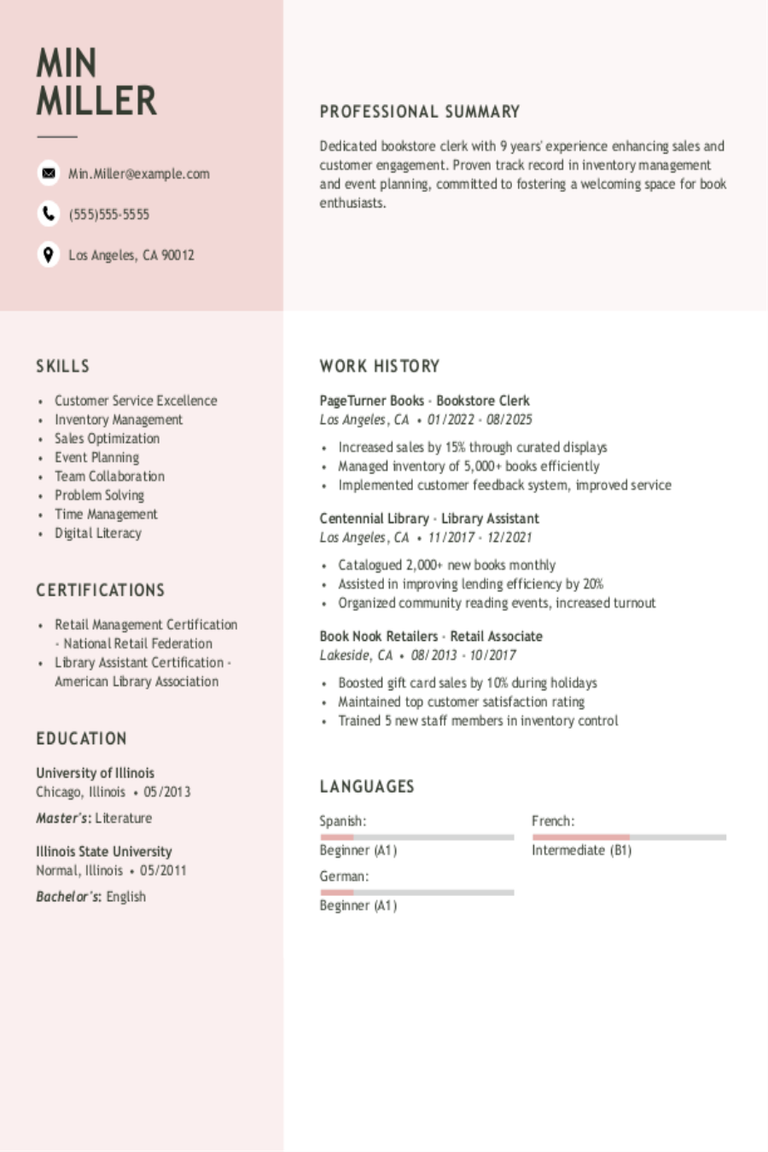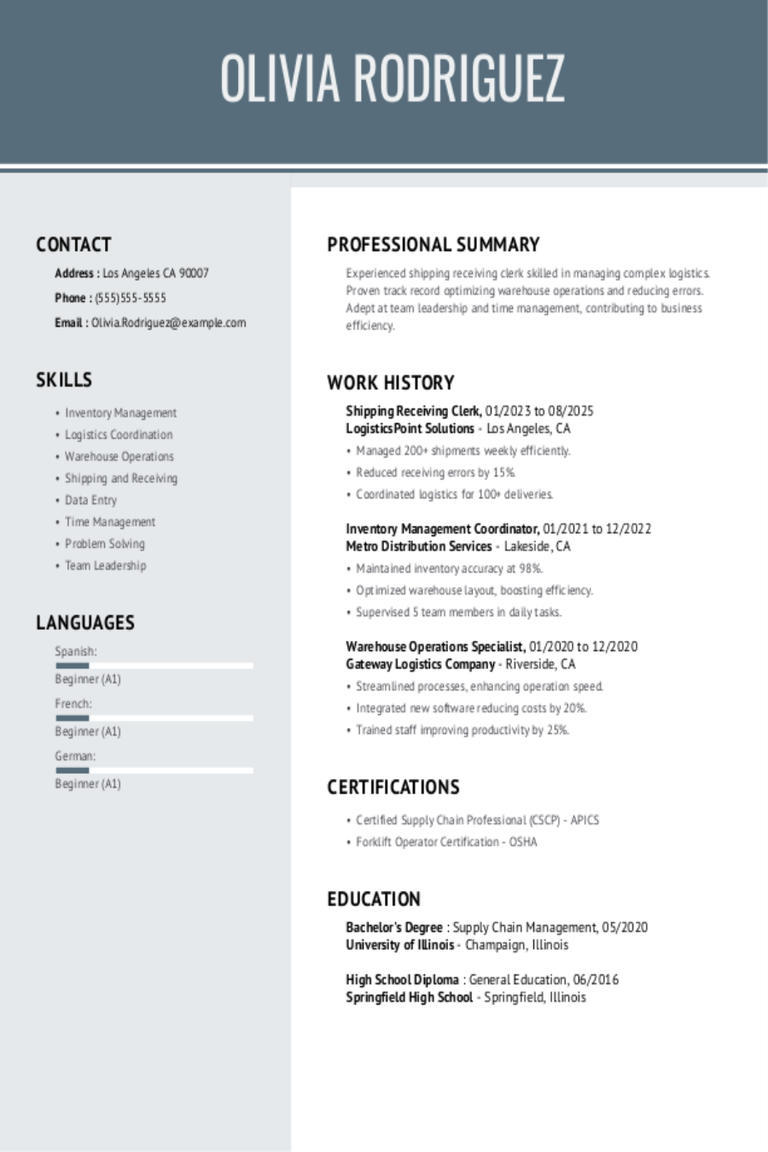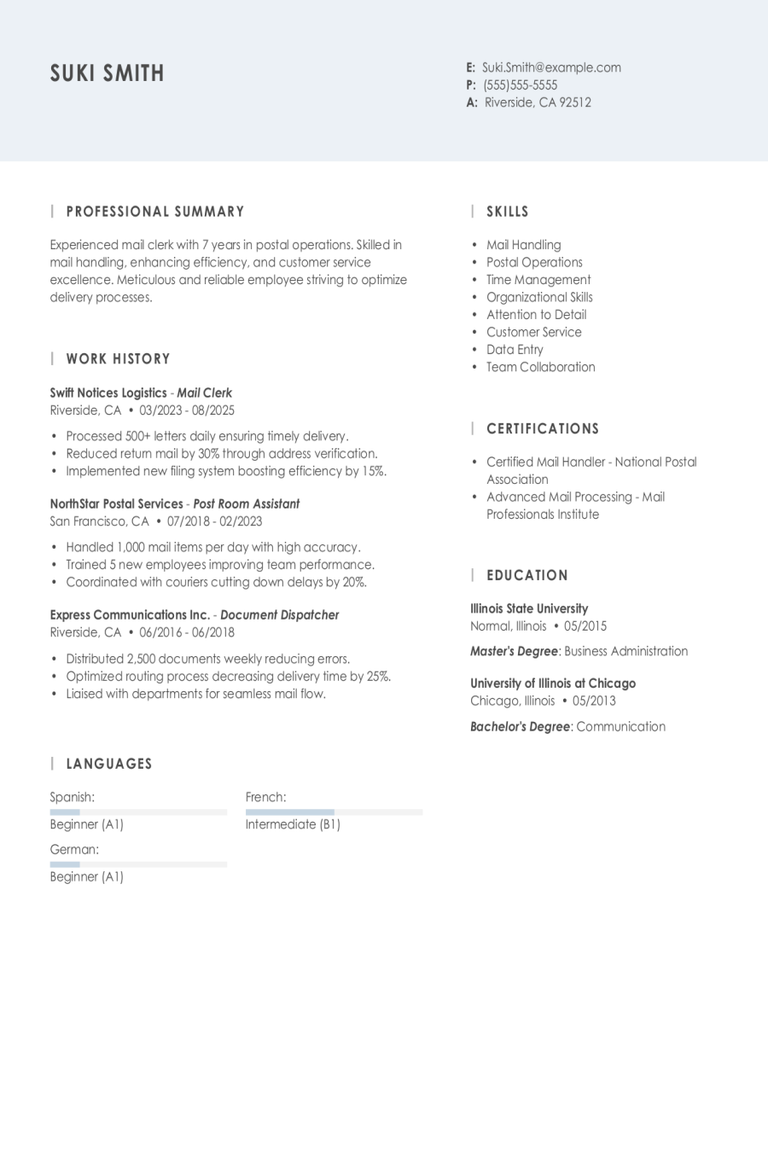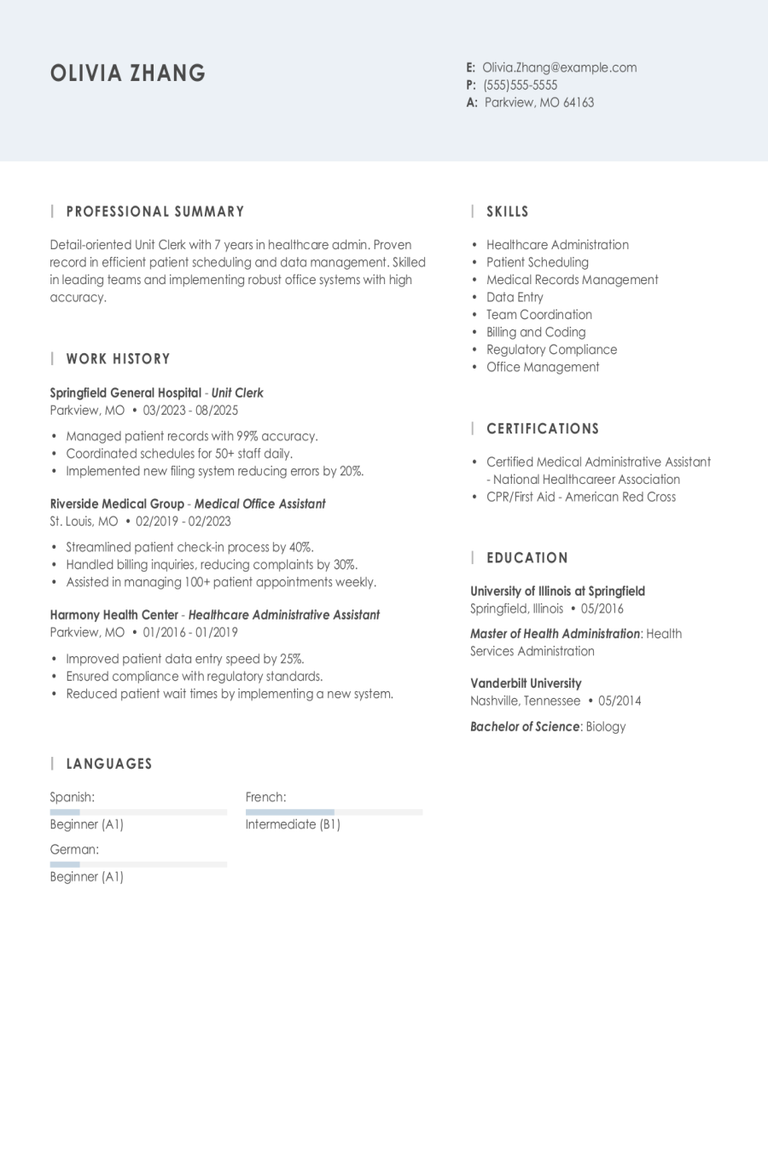Why this resume works
- Quantifies accomplishments: By recovering $50K in overdue accounts, the applicant showcases measurable accomplishments and impactful financial strategies.
- Highlights industry-specific skills: The applicant’s expertise in ledger reconciliation and payroll administration highlights essential administrative skills for the accounting sector.
- Uses action-oriented language: Using action verbs like “reconciled” and “streamlined,” the resume reflects initiative and effectiveness through action-packed language.
More Accounting Clerk Resume Examples
Our accounting clerk resume examples provide insights into showcasing your bookkeeping, data entry, and financial reporting skills. Use these accounting resume samples to create a standout resume that emphasizes your attention to detail and organizational expertise.
Entry-Level Accounting Clerk
Why this resume works
- Centers on academic background: By showcasing advanced degrees, the applicant’s resume emphasizes their strong educational foundation, important for early-career professionals in accounting roles.
- Shows digital literacy: Using tools like QuickBooks and Excel showcases the applicant’s computer skills necessary for modern accounting environments.
- Puts skills at the forefront: The resume’s layout highlights key skills such as financial reporting and data analysis, aligning with a skills-based resume format ideal for entry-level positions.
Mid-Level Accounting Clerk
Why this resume works
- Points to measurable outcomes: Demonstrating a knack for efficiency, the applicant’s success in reducing invoice discrepancies by 30% showcases their impact on organizational accuracy through measurable outcomes.
- Includes a mix of soft and hard skills: Mixing technical acumen and interpersonal skills, the applicant excels at ERP implementation while fostering vendor relationships, showcasing a well-rounded skill set.
- Clear contact information: A polished resume header ensures readability, making it easy for potential employers to initiate contact and discuss promising opportunities.
Experienced Accounting Clerk
Why this resume works
- Focuses on work history: Using a chronological resume format, the applicant showcases extensive experience, highlighting roles and achievements that demonstrate growth in financial management over many years.
- Lists relevant certifications: The inclusion of certifications like Certified Bookkeeper reflects a commitment to learning and accounting expertise.
- Emphasizes leadership skills: Through leading budget collaboration across eight departments, the applicant reveals strong leadership skills and problem-solving abilities.
Accounting Clerk Resume Template (Text Version)
Sophia Singh
Spokane, WA 99206
(555)555-5555
Sophia.Singh@example.com
Professional Summary
Detail-oriented accounting clerk with 5 years of experience in financial reporting, ledger reconciliation, and invoice processing. Proven success in reducing discrepancies and optimizing workflows, improving efficiency by up to 30%. Proficient in QuickBooks, Excel, and budget management, with expertise in audit preparation.
Work History
Accounting Clerk
Summit Financial Services – Spokane, WA
January 2023 – June 2025
- Reconciled monthly ledgers, improving accuracy by 15%.
- Processed invoices, reducing errors by 20% via automation.
- Maintained accounts payable for 50+ vendors efficiently.
Accounts Assistant
Pinnacle Accounting Solutions – Silverlake, WA
June 2020 – December 2022
- Tracked expenses, reducing budget discrepancies by 12%.
- Prepared weekly financial reports for 5 departments.
- Streamlined ledger entries, saving 8 hours/month on tasks.
Junior Accountant
Evergreen Financial Group – Tacoma, WA
June 2018 – May 2020
- Recovered K in unpaid invoices within 3 months.
- Assisted in audits, increasing compliance by 10%.
- Supported payroll processing for 100 employees monthly.
Skills
- Accounts Payable/Receivable
- Financial Reporting
- Ledger Reconciliation
- Invoice Processing
- Budget Management
- Audit Preparation
- Payroll Administration
- Data Entry Accuracy
Education
Master’s Accounting
University of California, Berkeley Berkeley, California
May 2018
Bachelor’s Finance
University of Washington Seattle, Washington
May 2016
Certifications
- Certified Bookkeeper – The American Institute of Professional Bookkeepers
- Microsoft Excel Specialist – Microsoft
- QuickBooks ProAdvisor – Intuit
Languages
- Spanish – Beginner (A1)
- French – Beginner (A1)
- German – Intermediate (B1)
Related Resume Guides
Advice for Writing Your Accounting Clerk Resume
Explore our expert tips on how to write a resume for an accounting clerk position and discover how to highlight your knack for numbers and organizational skills.
Highlight your most relevant skills
Listing relevant skills when applying for an accounting clerk job is important because it shows employers that you have the abilities they need. A dedicated skills section helps highlight your technical skills, such as bookkeeping, data entry, and using accounting software.
It also shows off your interpersonal skills like communication, teamwork, and attention to detail. Balancing both types of skills can give employers a complete picture of what you bring to the table. It’s smart to weave key skills into your work experience section, too.
For example, if you mention reconciling accounts in a past job, note how your accuracy saved time for the team. This makes your resume stronger by showing how you used these skills on the job. Remember to be clear and specific about your abilities so that hiring managers see why you’re a good fit for an accounting clerk role.
When filling out the skills section, focus on what’s most relevant to an accounting clerk position. Think about what tasks you’ll be doing and which skills will help you succeed. Highlighting both technical and soft skills gives a balanced view of your capabilities and makes it easier for employers to understand why you’d be great at this job.
Selecting a resume format that highlights accuracy, attention to detail, and financial record-keeping skills can help accounting clerks make a strong impression.
Showcase your accomplishments
When organizing your work experience as an accounting clerk, list your jobs in reverse chronological order. Start with your most recent position and work backwards. For each job, include the job title, employer name, location, and dates of employment to give a clear timeline of your career.
Quantifying your accomplishments makes your resume stand out more than just listing job duties. Instead of saying you “prepared financial reports,” show the impact by stating you “reduced report preparation time by 20% through improved processes.” This turns a duty into an achievement that demonstrates your skills and contributions clearly.
Use action-oriented words like “implemented,” “improved,” or “achieved” when describing what you did in each role. Focus on measurable results such as percentages, cost savings, or efficiency improvements. These quantified accomplishments help hiring managers quickly see how you can make a positive impact in their organization based on your past performance.
5 accounting clerk work history bullet points
- Processed and reconciled over 500 invoices monthly, improving accounts payable efficiency by 25%.
- Implemented a new data entry system that reduced errors by 40% and increased processing speed.
- Collaborated with the finance team to reduce outstanding receivables by $100,000 within six months.
- Generated accurate financial reports for quarterly audits, contributing to a 10% reduction in audit discrepancies.
- Streamlined payroll operations, reducing processing time from four days to two days per cycle.
Choose a resume template that’s clear and simple, with bold headings and readable fonts; this way, employers will focus on your skills and experience rather than flashy designs.
Write a strong professional summary
A professional summary is a brief introduction on your resume that presents your qualifications to hiring managers. It helps them decide quickly if your resume deserves a closer look. You can choose between a professional summary and a resume objective based on your experience level.
A professional summary highlights your experience, skills, and achievements in three to four sentences. It’s best for experienced applicants who want to showcase their professional identity and the value they bring.
In contrast, resume objectives state career goals and are ideal for entry-level applicants, career changers, or those with gaps in employment. Objectives focus on “what I aim to contribute,” helping to explain how your aspirations align with the role you seek.
We’ll provide examples of both summaries and objectives tailored to different industries and experience levels, including those suited for an accounting clerk position. Explore our full library of resume examples for additional inspiration.
Accounting clerk resume summary examples
Entry-level
Recent accounting graduate with a Bachelor of Science in Accounting from Temple University, eager to apply academic knowledge in a practical setting. Equipped with strong foundational skills in bookkeeping, accounts payable/receivable, and financial reporting. Proficient in Microsoft Excel and QuickBooks, with a keen interest in learning more about tax preparation and auditing.
Mid-career
Accounting clerk with over five years of experience managing financial records for mid-sized businesses. Well-versed in processing payroll, reconciling bank statements, and preparing monthly financial reports. Known for attention to detail and accuracy, as well as the ability to meet tight deadlines. Familiar with ERP systems like SAP and Oracle Financials.
Experienced
Seasoned accounting clerk with 10+ years of experience specializing in financial analysis and budgeting within the manufacturing industry. Expertise in optimizing accounting processes, reducing discrepancies by implementing new verification procedures. Recognized for leadership abilities and mentoring junior accounting staff, consistently achieving cost savings through strategic planning.
Accounting clerk resume objective examples
Entry-level
Detail-oriented accounting graduate seeking an entry-level accounting clerk position to use strong analytical skills and foundational knowledge of financial principles. Eager to contribute to a team by efficiently managing financial records and supporting accurate data processing.
Career changer
Organized professional with experience in administrative roles, transitioning into the accounting field as an accounting clerk. Looking to apply strong problem-solving skills and keen attention to detail while learning and growing within a dynamic finance department.
Entry-level with internship experience
Ambitious recent intern with hands-on experience in accounts payable and receivable, seeking an accounting clerk role. Committed to supporting the finance team through effective communication, diligent record-keeping, and timely processing of financial transactions.
Make your accounting clerk resume stand out! Use our Resume Builder to quickly organize your skills and experience into a professional-looking format.
Match your resume to the job description
Tailoring your resume to the job description is key for standing out. Many employers rely on applicant tracking systems (ATS) to identify suitable candidates. These systems scan resumes for keywords and phrases from the job posting.
Creating an ATS-friendly resume involves adding keywords that match the job description. This approach ensures hiring managers see how your skills align with their needs, boosting your chances of moving forward in the process.
To find relevant keywords in a job posting, focus on repeated skills and responsibilities. For example, terms like “data entry,” “financial reporting,” or “account reconciliation” often appear in accounting clerk roles. Incorporate these exact phrases into your resume where applicable.
Adding these terms naturally is essential. Instead of saying “Handled invoices,” switch it up with something like “Managed invoice processing using financial software” to better reflect language from the job post and showcase specific expertise.
When you customize your resume with targeted keywords and clear descriptions of your experience, it’s more likely to pass through ATS filters and reach decision-makers. This strategy increases your odds of securing interviews by ensuring both technology and humans can spot your qualifications.
Make your resume shine! Our ATS Resume Checker reviews your resume and gives quick tips to help you stand out to hiring managers.
FAQ
Do I need to include a cover letter with my accounting clerk resume?
Yes, adding a cover letter with your accounting clerk resume can help you stand out to employers.
A cover letter allows you to express your enthusiasm for the specific company and role while highlighting relevant experiences or skills unique to accounting.
For instance, if the company uses software like QuickBooks or SAP, mention any experience you have with these tools and how they benefit their team.
Consider using our Cover Letter Generator to create a personalized cover letter that closely matches the job description and showcases your strengths in detail.
Exploring cover letter examples tailored for accounting roles can also offer inspiration and help you structure your own effectively.
How long should an accounting clerk’s resume be?
For an accounting clerk, aim for a concise one-page resume that highlights your core skills, like skill in accounting software, data entry accuracy, and familiarity with bookkeeping tasks. Keep the focus on relevant experience, such as working with accounts payable/receivable or reconciling financial records.
If you’ve been in the field for many years or hold specialized certifications like QuickBooks or Excel expertise, a two-page resume might be acceptable. Just ensure every detail adds value and reflects directly on the role you’re targeting.
Explore our guide on how long a resume should be to determine what works best for your career stage.
How do you write an accounting clerk resume with no experience?
If you’re aiming for an accounting clerk position but lack direct experience, emphasize your relevant skills, education, and any practical experiences related to accounting or finance. Here are a few tips:
- Emphasize your education: Start with your degree in accounting or a related field. Include any coursework that’s particularly relevant, like financial accounting, bookkeeping, or business math.
- Highlight transferable skills: Detail skills such as skill in Microsoft Excel, data entry accuracy, attention to detail, and organizational abilities. These are important for an accounting clerk role.
- Include internships or volunteer work: If you’ve done internships or volunteered where you handled tasks like data management or used financial software, make sure to include these experiences.
- Showcase relevant projects: Mention academic projects that involved budget management or financial analysis. This can demonstrate your practical understanding of key accounting principles.
Explore our guide on how to write a resume with no experience for additional tips on writing an effective resume for entry-level roles.
Rate this article
Accounting Clerk
Additional Resources

Convenience Store Clerk Resume Examples & Templates for 2025
Discover how convenience store clerks can showcase their skills in handling cash, stocking shelves, and assisting customers efficiently. These resume examples and tips will help you highlight your experience to

Bookstore Clerk Resume Examples & Templates for 2025
Learn how to create a standout resume for a bookstore clerk job. These resume examples and tips show you how to highlight your ability to help customers, manage inventory, and

Warehouse Clerk Resume Examples & Templates for 2025
Find warehouse clerk resume examples that focus on organization, inventory tracking, and teamwork. Discover how to show you’re dependable, detail-focused, and ready to keep things running smoothly.Build my resumeImport existing

Shipping Receiving Clerk Resume Examples & Templates for 2025
Discover shipping receiving clerk resume examples and learn how to showcase your work experience to attract logistics employers.Build my resumeImport existing resumeCustomize this templateWhy this resume worksHighlights industry-specific skills: Through roles

Mail Clerk Resume Examples & Templates for 2025
Discover mail clerk resume examples and learn how to showcase their skills in sorting and delivering mail efficiently.Build my resumeImport existing resumeCustomize this templateWhy this resume worksQuantifies accomplishments: By reducing return

Unit Clerk Resume Examples & Templates for 2025
Explore unit clerk resumes that focus on scheduling, patient communication, and record management. Discover tips to showcase your ability to keep things organized and support healthcare staff efficiently.Build my resumeImport
